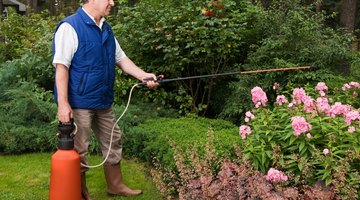What to Do If Malathion Is Spilled in a Garage?
Malathion belongs to a category of pesticides called organophosphates, which are phosphorus-based compounds that kill insects and animals by acting against the nervous system.

As of 2014, the EPA has determined that, when used under strict controls according to EPA guidelines, malathion is unlikely to pose unreasonable risks to humans and pets, but household and accidental spills of undiluted malathion are a greater threat and should be managed according to particular safety concerns in order to avoid major health risks, including death.
Malathion Risks
Malathion is toxic if ingested, inhaled or contacted via skin exposure. Topical or inhalation exposure may cause pain in the eyes, skin and nasal passages, and abdominal discomfort. High exposure levels may cause nerve damage and even death. The Occupational Health and Safety Association has determined that the effects of acute toxicity may be felt in exposure levels as low as 15 milligrams per cubic meter of workspace, according to the 2009 guidelines. At 140 milligrams per cubic meter, inhaled malathion can be deadly to healthy adults. Children, pregnant women, the elderly, people with underlying medical conditions, and household pets may experience more serious health consequences at lower exposure levels. If you experience any discomfort during a spill clean-up, immediately remove yourself and call 911 or poison control.
Safety Considerations
Protective clothing, including gloves, long-sleeved shirts, long pants, and impact-resistant eye protection like goggles should be worn. A full-coverage respirator is necessary for any exposure over 1 milligram per cubic meter; if you are unsure of the exposure concentration, wear a respirator as a proactive measure. All clothing should be immediately removed and laundered after clean-up. Ensure that there are no ignition risks, including open flames and pilot lights, in the spill area. Contain the spill as quickly as possible by righting any tipped containers. Ventilate the area, but be mindful of wind; if you open the garage door on a windy day for ventilation, powdered malathion may pose an increased inhalation risk due to being blown about. Keep pets, children and other susceptible people away from the spill area for the duration of clean-up, and up to several days following.
Clean-up
Apply a generous layer of vermiculite, sand or even household cat litter to absorb as much of the spill as possible. Once absorbed, scoop or sweep the material into a sealable, disposable container. Ventilate the area as much as you are able, including opening windows or garage doors and running fans. To decontaminate the area affected by the spill, the Armed Forces Pest Management Board recommends cleaning the floor with lye or lime. To avoid the possible effects of corrosion, and to limit the possibility of injuring yourself via accidental skin contact, use a pre-mixed solution of lye diluted with water and follow the package instructions for cleaning the floor. Prevent run-off from flowing into nearby sewers, drains or waterways, as malathion is harmful to aquatic life.
Disposal
Malathion should be disposed of in a sealed container at a landfill that is licensed to accept hazardous waste. If you are unsure of the best way to dispose of the chemical, call your local waste management office, state Department of Environmental Protection, or the nearest office of the U.S. Environmental Protection Agency. A representative will be able to direct you to a landfill that is designated to accept hazardous waste, or provide additional instructions for safe disposal. Some municipal hazardous waste collection events also accept household pesticides, but this will vary by location.
The Drip Cap
- Malathion belongs to a category of pesticides called organophosphates, which are phosphorus-based compounds that kill insects and animals by acting against the nervous system.
- High exposure levels may cause nerve damage and even death.
- Ensure that there are no ignition risks, including open flames and pilot lights, in the spill area.
- To decontaminate the area affected by the spill, the Armed Forces Pest Management Board recommends cleaning the floor with lye or lime.
- To avoid the possible effects of corrosion, and to limit the possibility of injuring yourself via accidental skin contact, use a pre-mixed solution of lye diluted with water and follow the package instructions for cleaning the floor.
- Prevent run-off from flowing into nearby sewers, drains or waterways, as malathion is harmful to aquatic life.
References
- Environmental Protection Agency: Malathion Results
- Air Force Pest Management Board: Pesticide Spill Prevention and Management
- New Jersey Department of Health and Senior Services: Hazardous Substance Fact Sheet
- Agency for Toxic Substances and Disease Registry: Malathion
- Crop Data Management Systems: Safety Data Sheet
Writer Bio
Hannah Wahlig began writing and editing professionally in 2001. Her experience includes copy for newspapers, journals and magazines, as well as book editing. She is also a certified lactation counselor. She holds a Bachelor of Arts in English from Mount Holyoke College, and Master's degrees in education and community psychology from the University of Massachusetts.
Photo Credits
- Dmitrijs Dmitrijevs/Hemera/Getty Images
- Dmitrijs Dmitrijevs/Hemera/Getty Images
More Articles



